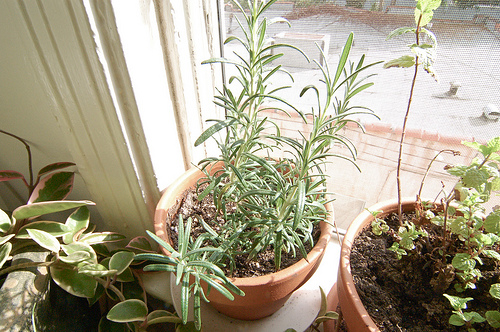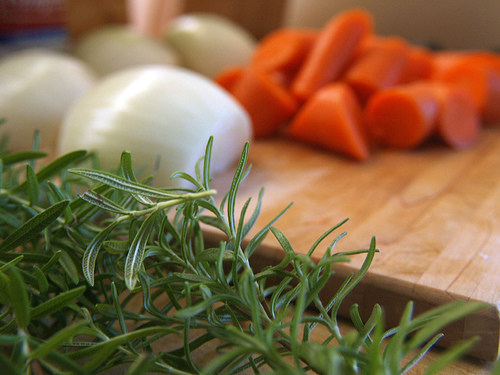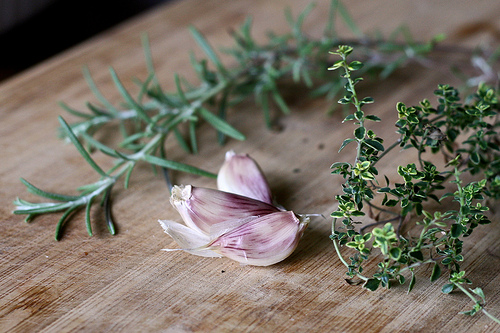Rosemary’s aromatic flavor has been cherished by cooks and gardeners for centuries. The Mediterranean herb adds delicious fragrant taste to whole chickens, roasted potatoes, grilled steaks, steamed vegetables and so much more. Growing rosemary indoors in winter lets you enjoy this popular herb, when everything else in your garden looks dead or dormant.
 Snowbound rosemary photo via KennethMoyle/Flickr Creative Commons
Snowbound rosemary photo via KennethMoyle/Flickr Creative Commons
How to grow rosemary indoors
Growing it
When temperatures drop into the 30s outdoors, it’s time to bring your rosemary indoors. First, the bad news: Rosemary can be a little tricky to grow indoors. But growing rosemary indoors in winter is certainly possible with the right gardening conditions. For best results, give these plants plenty of sunlight. This sun-loving herb likes a window with southern exposure, and at least 4 hours of direct sunlight. If you don’t have a south, west or southwest facing window, you may need to provide supplemental light. Rotate your plant weekly so the rosemary gets sunlight on all sides.
 Herb garden via Sweetbeetandgreenbean/Flickr Creative Commons
Herb garden via Sweetbeetandgreenbean/Flickr Creative Commons
Overwatering rosemary is a great way to kill this plant. Water this drought-tolerant plant when the first inch of soil is dry. Make sure your container has excellent drainage too; this helps prevent root rot. Prune rosemary stems to maintain the plant’s shape, and enjoy the leaves in your meals. Any dead or brown branches should be pruned away as soon as possible.
Propagate it
It’s not easy to grow rosemary from seed, but you can also find small transplants at nurseries. Rosemary is easy to propagate, and plants are often started from cuttings.
- Clip a couple inches of new growth off an established rosemary plant.
- Carefully snip away the bottom leaves, and dip the bottom stem into a hormone rooting powder.
- Plant the cuttings in small containers with peat moss and perlite.
- Lightly mist the cuttings, and the plants will start rooting.
Challenges
Powdery mildew is a white coating on the leaves, which sometimes appears on rosemary plants grown indoors. Some experts recommend you run a small fan near the plant for a couple hours a day to increase the air circulation in the room. And be sure to keep rosemary plants away from heater drafts.
Spider mites can cause white dots and webbing on rosemary plants. Give your rosemary periodic showers to help control the pests.
 Rosemary photo via jamailac/Flickr Creative Commons
Rosemary photo via jamailac/Flickr Creative Commons
Serving tips
Rosemary features prominently in Italian cuisine, Spanish cuisine and French cuisine. And there are so many wonderful ways to use this fragrant herb in the kitchen and add a flavor burst to your meals.
- Throw a few sprigs into a soup or stew, and simply remove the herb before you eat.
- Use rosemary sprigs as skewers for veggies on a grill.
- Infuse a bottle of olive oil with a couple rosemary sprigs.
- Or, swirl rosemary leaves into butter, and serve with everything from fresh-baked dinner rolls to corn-on-the-cob.
From flavored butters to rosemary-infused honeys, there are lots of fun ways to preserve rosemary for cold-weather meals.
 Rosemary, garlic and thyme photo via Chiot’s Run/Flickr Creative Commons
Rosemary, garlic and thyme photo via Chiot’s Run/Flickr Creative Commons
Rosemary mixes well with garlic, thyme and sage. The herb also blends beautifully with lemons.
- Make your next pitcher of lemonade with a sprig of rosemary.
- Or, mix chopped rosemary leaves, lemon juice, garlic and olive oil for a dipping sauce for vegetables.
- When cooking chicken, rub the bird with rosemary leaves and roast with lemons. Mixed with a little salt and pepper, this basic chicken recipe is a classic for spring meals. The same kind of flavoring also works well with roasted lamb.
- Rosemary is pungent enough to stand up to a hardy grilled steak. Try marinating the meat with rosemary and red wine first.
- Don’t forget roasted peppers, potatoes, onions and other vegetables. Brushed with olive oil and crushed rosemary leaves before cooking, these vegetables are elevated to an entirely different level.
Enjoy all these culinary delights year-round by growing rosemary indoors in winter winter. You’ll be so glad you did!
You might also enjoy our post on how to grow thyme indoors.

Great article on such a beautiful and fragrant herb! I love growing rosemary outdoors and cooking with it, but always had problems during the winter freezing months. This article will definitely help keep my rosemary alive and well. Thank You!